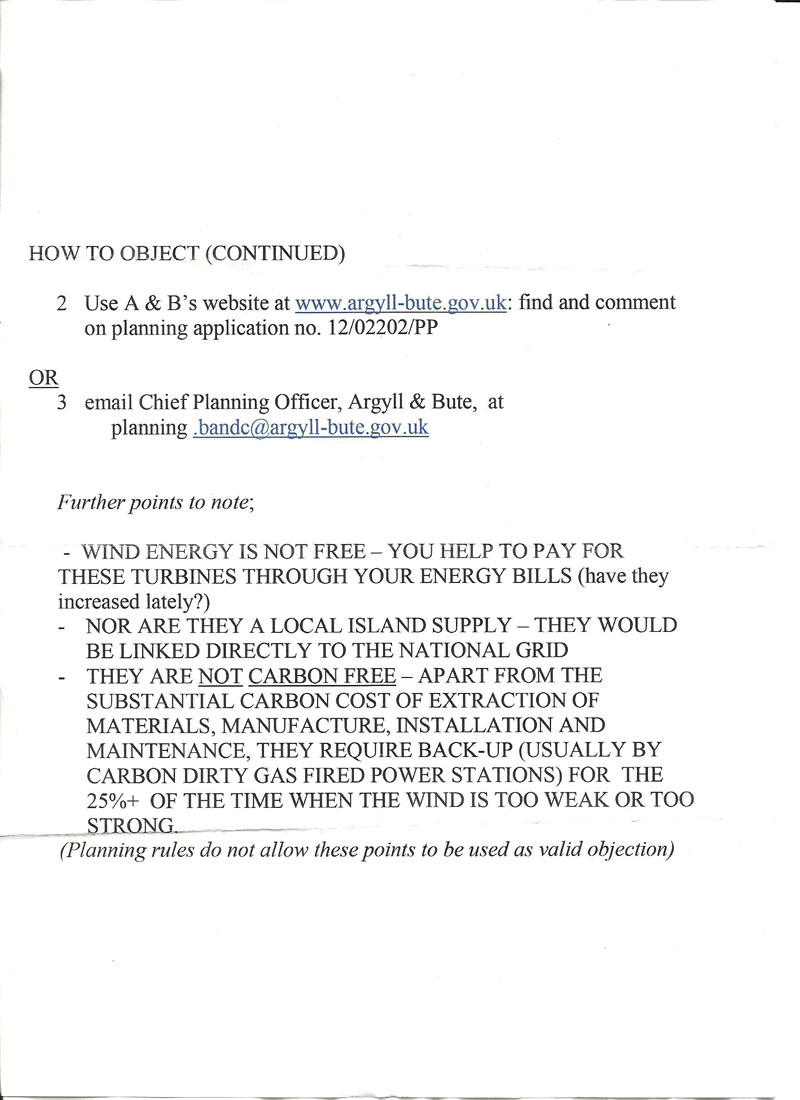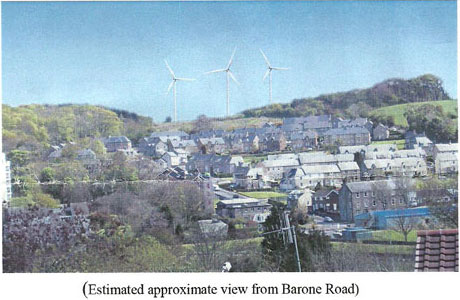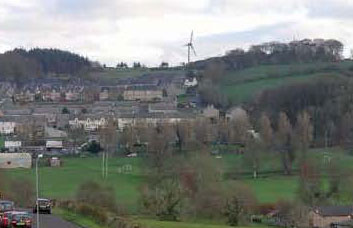Handbills, being delivered door-to-door by a small but presumably willing army of anti-wind campaigners, are now circulating around Bute – spreading complete misinformation about our proposed wind energy scheme and, on the face of it, trying to frighten people into submitting objections to the Argyll & Bute planning department.
The document submitted by the objectors featured a real ‘copy and paste’ special with a range of speculation, amateur graphics and spurious ‘information’.
How sad, now that the full Environmental Statement has been published that members of the anti-wind activist movement continue to attempt to spread misinformation and utterly misleading graphics when information about the project – including accurate computer-generated photomontages – are all available both on this site and on the Argyll & Bute Council web site (albeit in a more or less non-obvious way: follow the link, click on ‘View associated documents’ which should open a new window – unless you have a pop-up blocker, in which case disable it – then use the arrows or navigation to go to the last page or click the image and work backwards until you start to see the documents submitted, e.g. one titled Environmental Statement).
The flyers being punted around door-to-door are reproduced below. Typically – as many but not all of the documents in the anti-wind objection pack (3.2MB PDF) bear witness – no author is credited, although we have our suspicions about their true origin.
The lack of a name may, perhaps, prove fortunate for the author(s) and/or distributor(s) of the leaflets if we are advised that the presentation and dissemination of such material is actionable. ‘Concerned Residents’ may, of course, voice their concerns; but these should be based on fact and accurately reference the planning documents submitted.
Turning to the flyer in detail it is apparent that the wind turbines pictured look truly enormous, seemingly looming over the view from Barone Road:
Turbines this size would be visible from space! No wonder they are scaring people into objecting.
A more realistic view of the likely visual impact if the turbines are consented (from page 19 of Appendix F (Part II) of the planning documents [28MB PDF]) is given below:
Now, we don’t mind people objecting to our plans – although, of course, we’d love people to support clean, green, renewable energy generation that will financially benefit the community on Bute – but we do object very strongly to blatant misinformation. The whole point of conducting an extremely detailed Environmental Impact Assessment into the scheme is to present impartially gathered and factual information.
The flyer also mentions:
-
‘Noise’
The Environmental Statement (2.8MB PDF) deals with the subject of noise in Chapter 11 (page 258). It concludes that ‘Turbine noise levels anticipated at the four closest sensitive receptors, Ascog Farm, Ascog Lodge, Braeside and Vineries, have been calculated from noise data provided by the manufacturer. Comparison with the assessed background noise suggests that receptor turbine noise levels will exceed background levels by at most 4.6 dB(A). Thus the requirement in ETSU (1997) not to exceed 5 dB(A) above background is satisfied. This assessment indicates that the acceptability criteria for turbine noise in ETSU (1997) are met at all receptors considered.’ It is erroneous to suggest, as the flyer appears to, that noise will be a problem generally. -
‘Sunlight flicker’
The Environmental Statement (2.8MB PDF) deals with the subject of shadow flicker in Chapter 14 (page 287). This states that ‘When the sun shines through the blades of a rotating turbine shadow flicker can occur. This is caused by the light being interrupted by the blades. Specific Advice Note: Onshore Wind Turbines discusses the likelihood of shadow flicker from wind turbines and suggests that properties outwith 10 rotor diameters should not be affected…’ The properties Ascog Farm, Ascog Lodge, Ascog House, High Bogany, Vineries, Braeside, Beech Park and Clairmont Cottage were assessed for shadow flicker using ‘Windfarm Software Shadow Flicker Module’. This found that the first six of these properties may have a shadow flicker impact for a maximum of 40 hours/year. Since the orbit of the Earth around the Sun is now well known (Copernicus, 1473-1543) it is a simple matter to program the wind turbines to shut down during these periods as necessary. It is erroneous to suggest, as the flyer appears to, that shadow flicker will be a problem generally. -
‘Low frequency noise and vibration’
The suggestion of mysterious ‘low frequency noise’ causing sickness and health problems is frequently trawled up in anti-wind campaigns and has already been mentioned by alarmist anti-wind Tory MEP Struan Stevenson in ‘his’ letter to The Buteman. Since there is no evidence for it, and it is widely thought to be a concoction termed ‘Wind Turbine Syndrome’ it is not covered in the Environmental Statement. Renewables UK has an interesting analysis of the low-frequency noise ‘issue’ in which Dr Geoff Leventhall, Consultant in Noise Vibration and Acoustics and author of the 2003 Defra Report on Low Frequency Noise and its Effects, says: “I can state quite categorically that there is no significant infrasound from current designs of wind turbines.” It is erroneous (and alarmist) to suggest, as the flyer appears to, that low frequency noise and vibration will cause health problems generally.
Those gullible enough to believe in the truly gigantic wind turbines pictured in the anti-wind flyer – so big that one might well think they would cause noise or shadow flicker issues in a much wider area – may already have written with objections to the Council.
We have minds in order to use our intelligence. Having spent a great deal of time gathering impartial evidence into the plans for renewable wind energy generation at Ascog Farm it is only fair that citizens should be presented with facts rather than half-truths or misleading ‘information’.
Wind turbines are big, but they’re not as big as those pictured, won’t fry our brains or kill us in our sleep. They generate power without fuel, quickly repay the carbon cost of their construction and installation and – on a windy island with a generally poor economic outlook – actually offer a mechanism for generating revenue. This we are happy to share with those around us.
What’s not to like?



